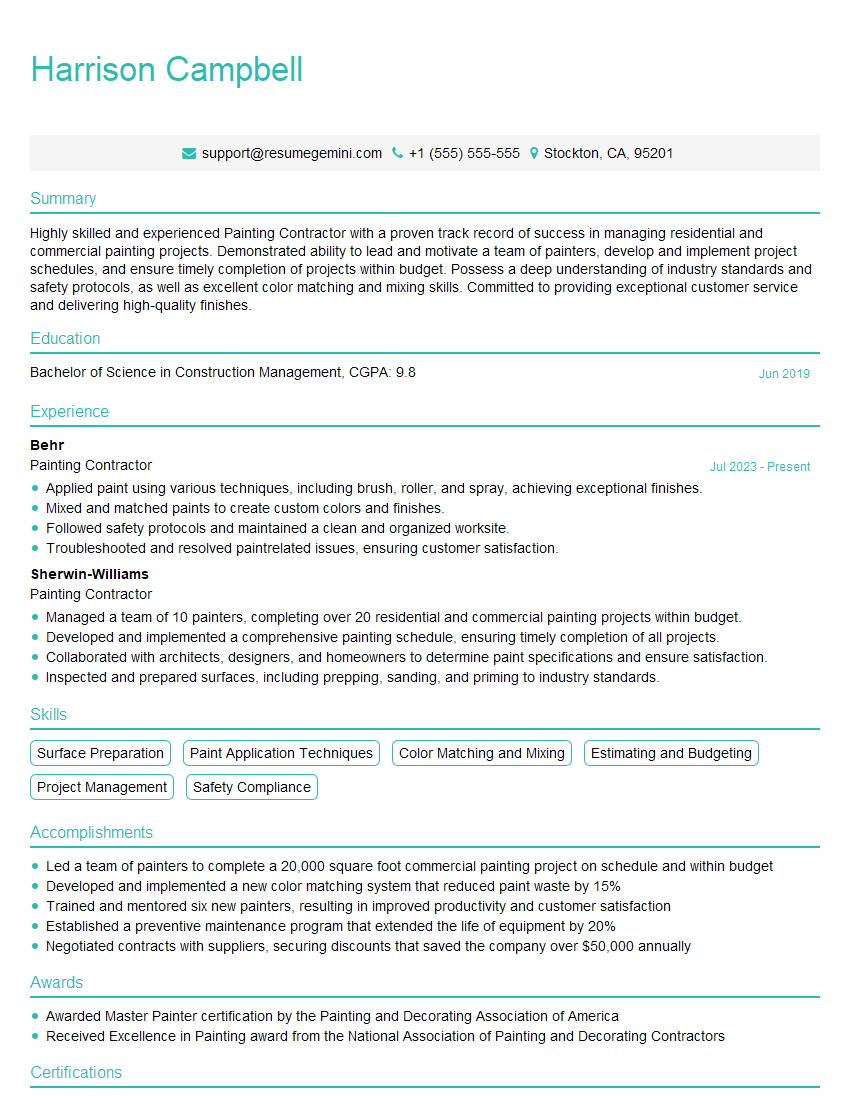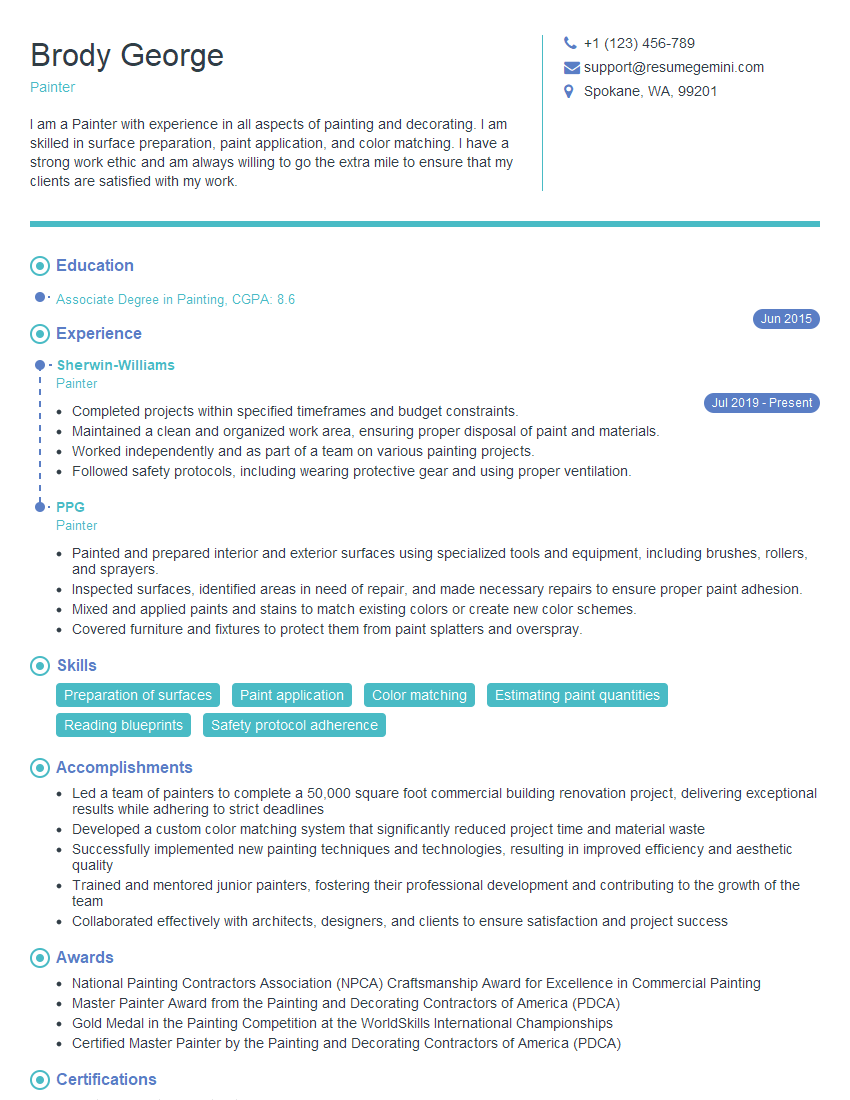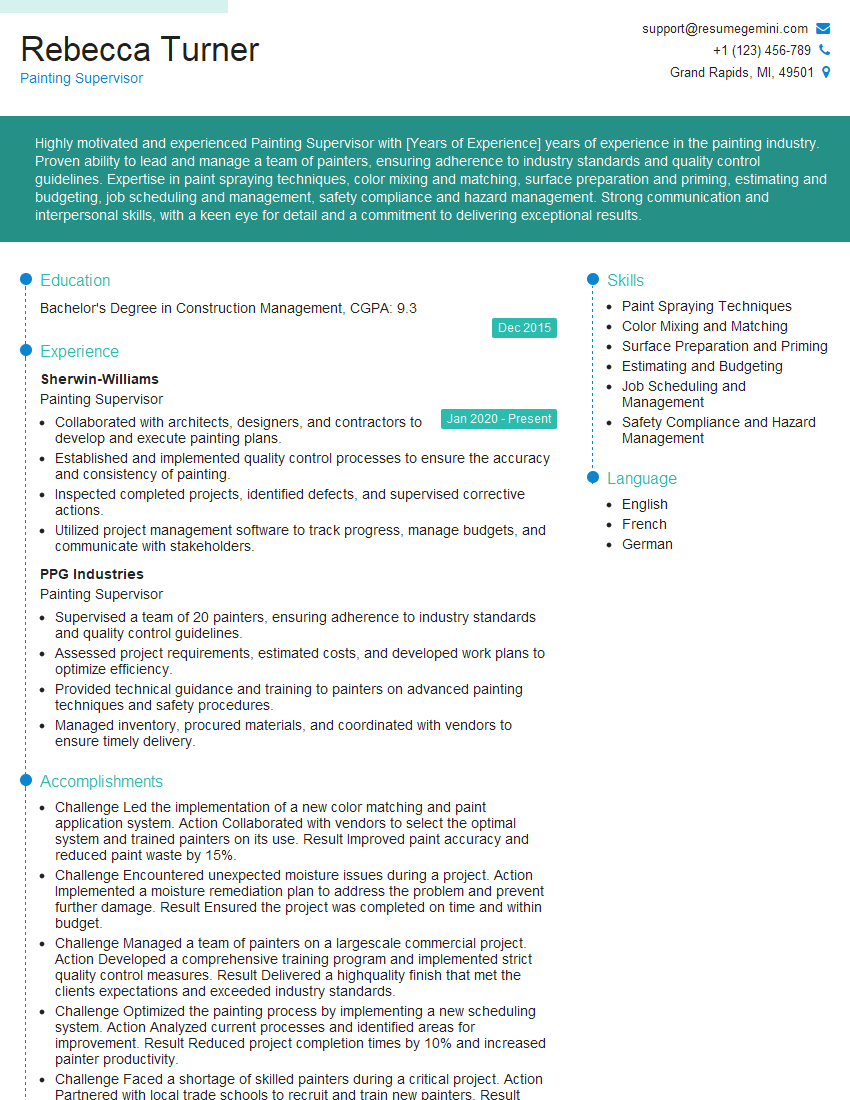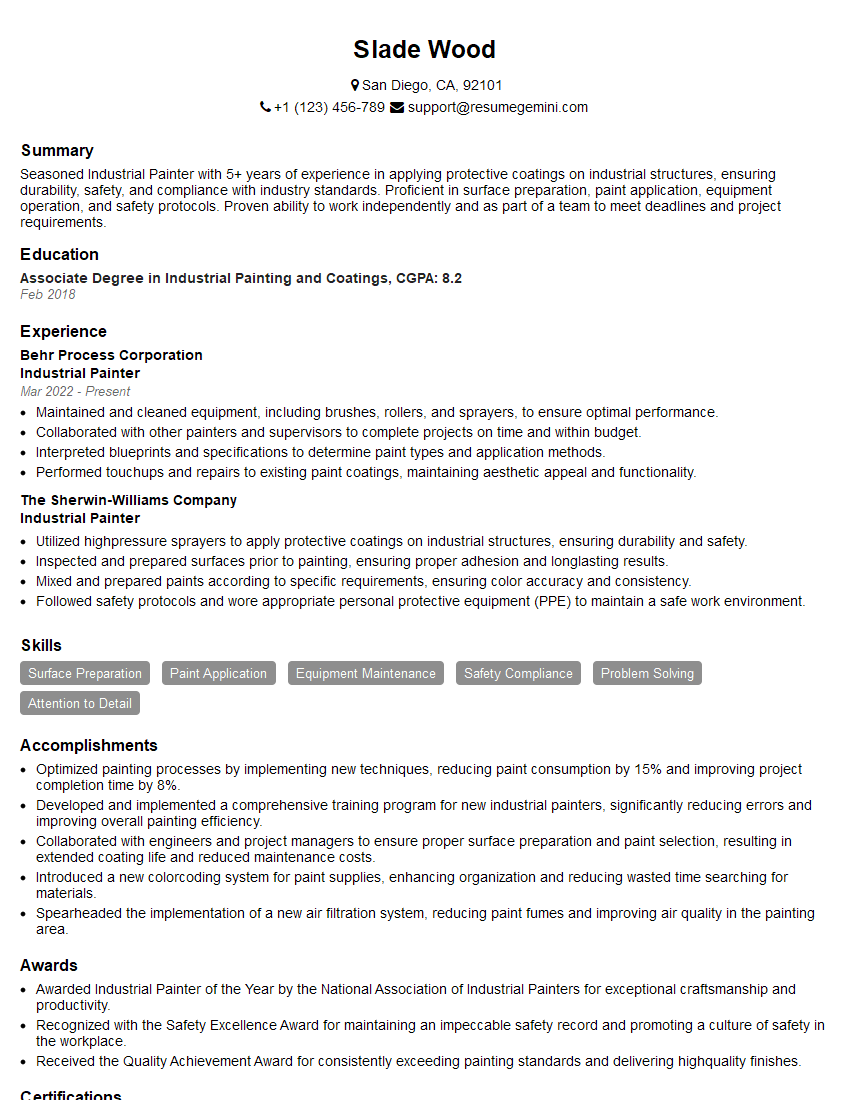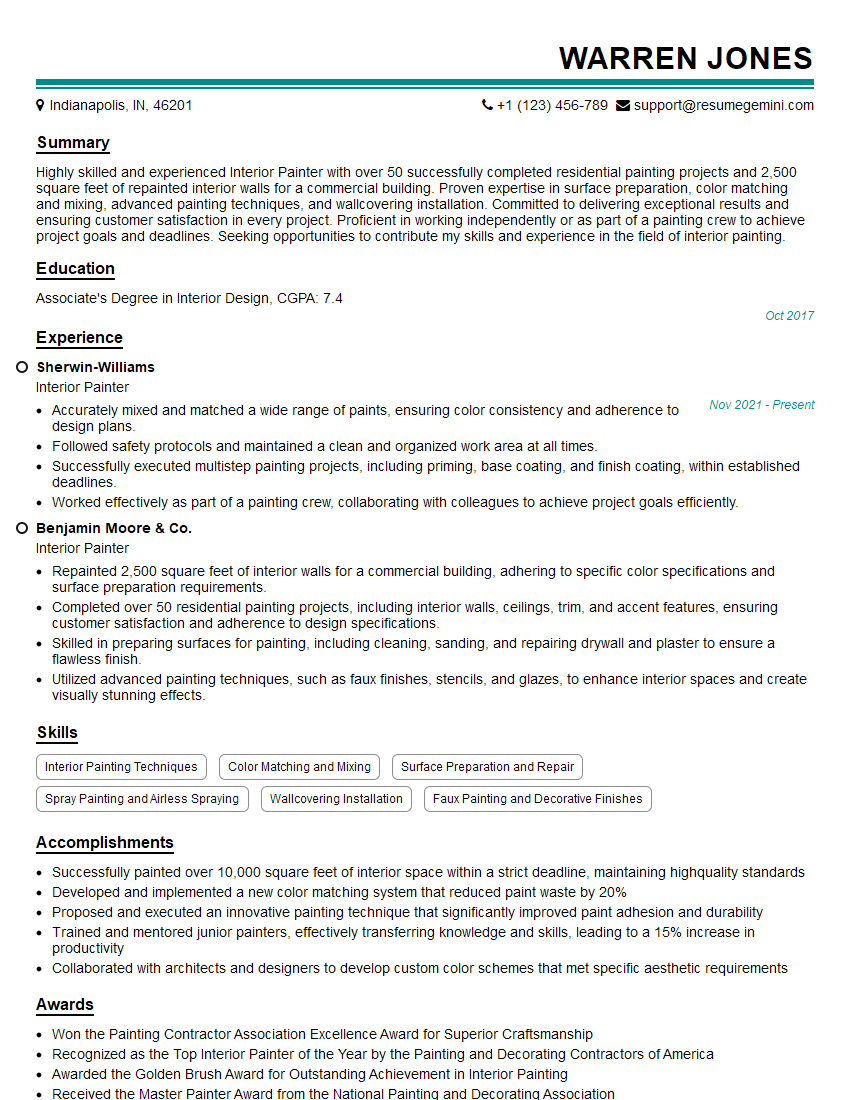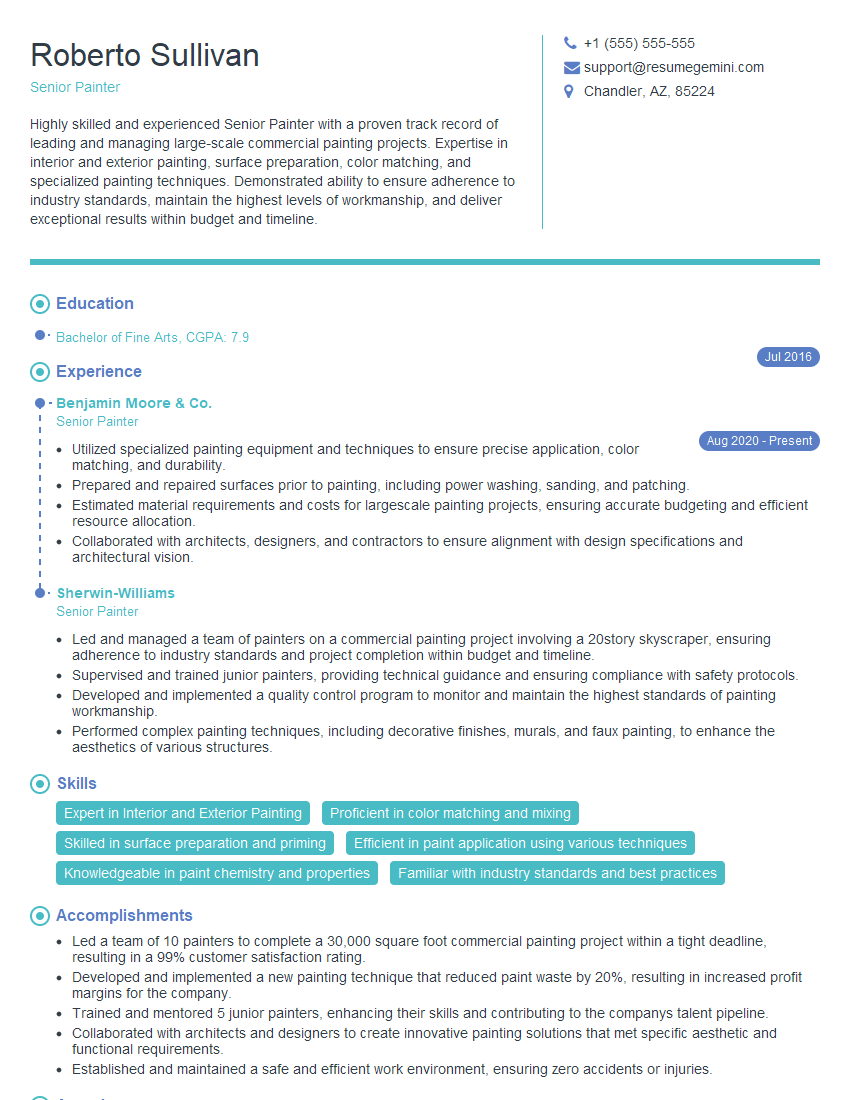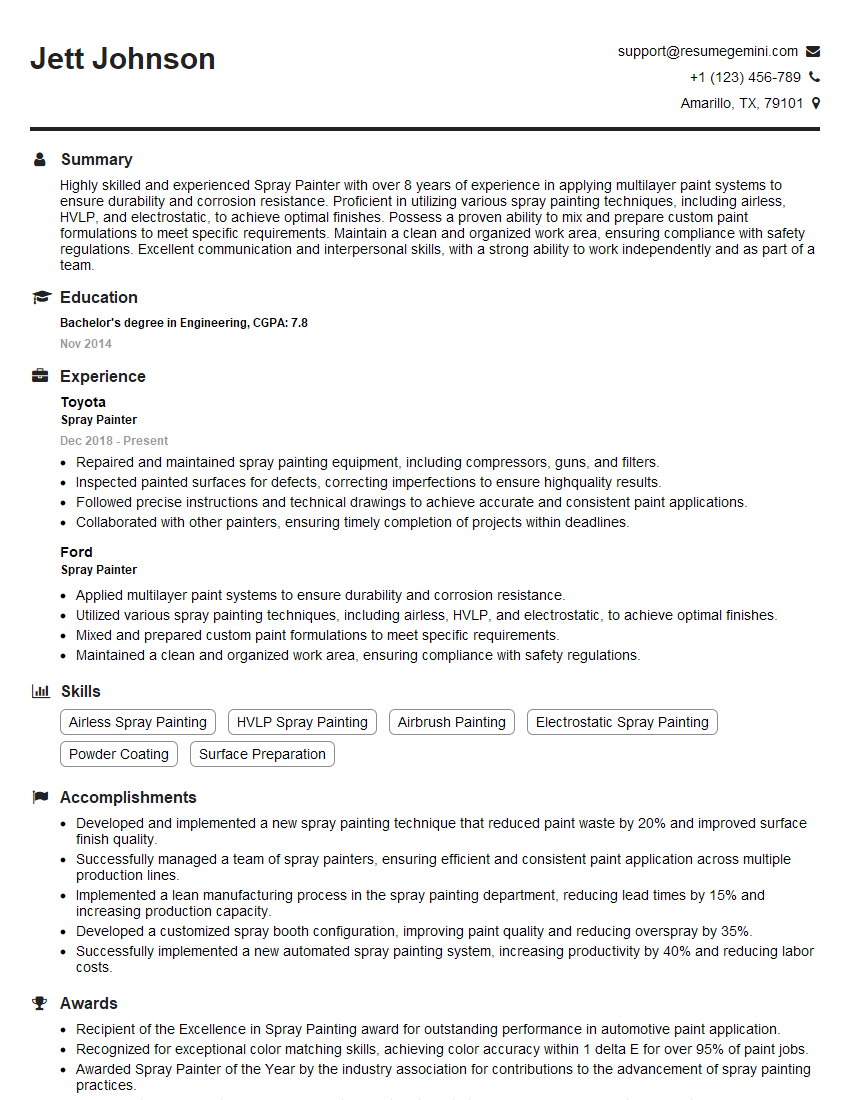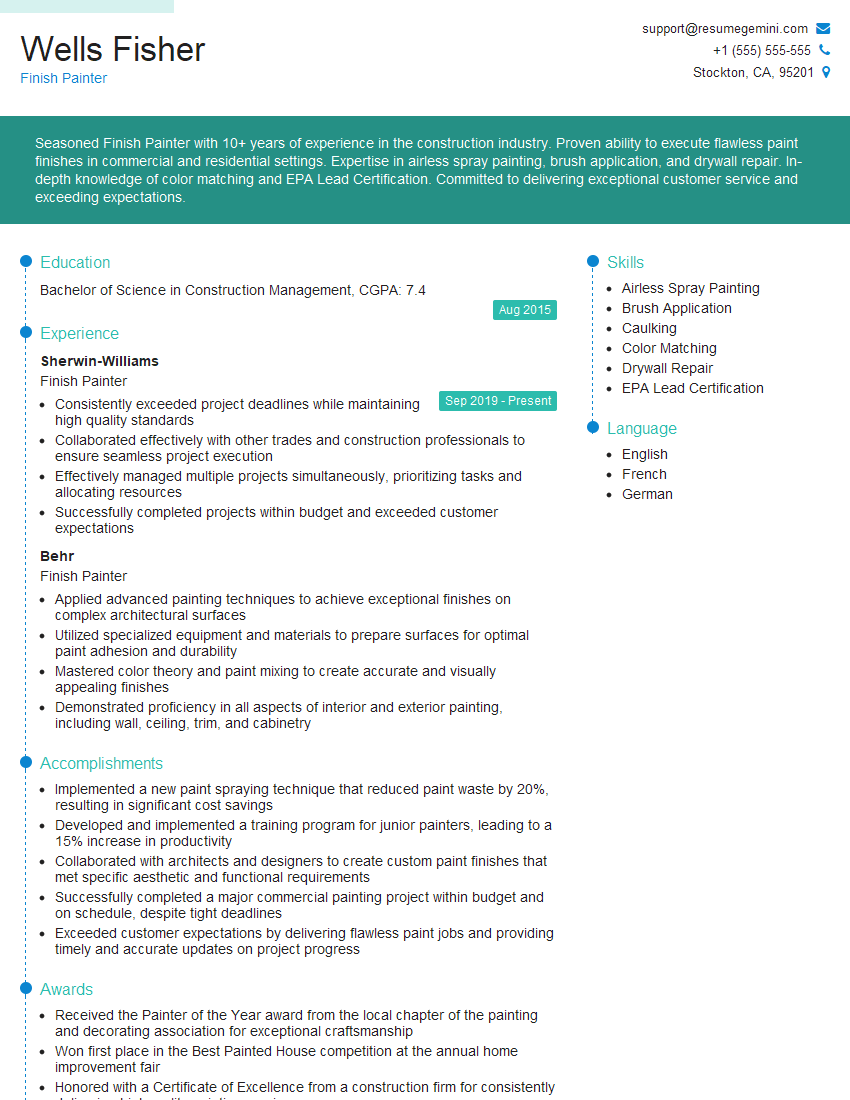Feeling uncertain about what to expect in your upcoming interview? We’ve got you covered! This blog highlights the most important Brush and Roller Painting interview questions and provides actionable advice to help you stand out as the ideal candidate. Let’s pave the way for your success.
Questions Asked in Brush and Roller Painting Interview
Q 1. What types of brushes and rollers are best suited for different paint types (e.g., latex, oil-based)?
Choosing the right brush or roller depends heavily on the paint type. Oil-based paints are thicker and require brushes and rollers with stiffer bristles to adequately distribute the paint. Latex paints, being water-based and thinner, work well with softer bristles.
- Oil-based paints: For oil-based paints, you’ll want to use brushes with natural bristles like hog bristle brushes. These bristles are durable enough to handle the thicker consistency. For rollers, a high-density woven fabric roller cover is ideal, designed to hold more paint and release it evenly.
- Latex paints: Synthetic bristle brushes, such as nylon or polyester, are best for latex paints. Their smooth bristles won’t get damaged by the water content and are easier to clean. For rollers, a microfiber or polyester roller cover works efficiently and smoothly, reducing splatter.
- Example: When painting trim with oil-based enamel, a high-quality 2-inch angled sash brush with natural bristles provides excellent control and precision. For a large wall area using latex, a 9-inch roller frame with a high-nap microfiber cover is efficient.
Q 2. Explain the proper techniques for cutting in and rolling paint to achieve a smooth, even finish.
Cutting in and rolling are crucial for a professional-looking finish. Cutting in refers to painting the edges of a wall, around windows and doors, creating a neat border before rolling. Rolling is the technique to cover the larger wall surface.
- Cutting in: Use a high-quality angled brush (2-3 inches wide) and work in small sections. Load the brush about ⅓ full to avoid dripping. Use smooth, controlled strokes, keeping the brush at a consistent angle to the surface. Aim for a smooth, even coating that extends slightly onto the adjacent area that you will be rolling.
- Rolling: Dip the roller into the paint tray, ensuring it’s adequately loaded without being dripping wet. Use an ‘M’ or ‘W’ pattern, overlapping each stroke by about 50%. This creates an even coat without streaks. Don’t overload the roller; it should roll smoothly, not drip. For larger walls, use a larger roller (9 inches or more) for faster coverage. When changing directions, use a smooth transition to prevent a hard line in the middle.
- Smooth Finish: A wet edge is critical. Work in sections, ensuring the previously painted section is still wet before you move into the next one, blending the sections seamlessly. Multiple thin coats are better than one thick coat, which can lead to drips and uneven coverage.
Q 3. How do you prepare a surface for painting (e.g., cleaning, priming, sanding)?
Surface preparation is paramount for a quality paint job. A poorly prepared surface can lead to peeling, cracking, and poor adhesion of the paint.
- Cleaning: Remove all loose dirt, dust, cobwebs, and grease. For really dirty surfaces, wash the area down with a suitable cleaner, rinsing thoroughly before proceeding.
- Repairing: Fill any holes or cracks with appropriate filler and allow it to dry completely before sanding smooth.
- Sanding: Light sanding helps create a smooth surface for better paint adhesion. Use fine-grit sandpaper (120-180 grit) to avoid scratching the surface.
- Priming: Priming is particularly important for new drywall, porous surfaces, or areas with stains. Primer seals the surface and provides a uniform base for the topcoat, resulting in a better finish and potentially less coats of paint needed. Choose a primer appropriate for the surface and the type of paint you will be using.
Q 4. Describe your experience with different paint application methods (e.g., brushing, rolling, spraying).
My experience encompasses all three common paint application methods: brushing, rolling, and spraying.
- Brushing: Excellent for detailed work like trim, doors, and intricate designs, providing precise control. It can also be used effectively on smaller surfaces.
- Rolling: Highly efficient for large flat surfaces like walls and ceilings, delivering even coverage quickly. Ideal for large projects.
- Spraying: This method is best suited for large areas and provides a smooth, even finish with minimal brushstrokes. Requires specialized equipment and safety precautions, and is less suitable for small projects or intricate details due to overspray.
- Example: On a recent project, I used spray painting to cover a large exterior wall, then employed brushing for trim work, and finally, used rolling to paint the interior walls of a large living room.
Q 5. What safety precautions do you take when using paint and painting equipment?
Safety is my top priority. Working with paint and painting equipment necessitates several crucial precautions.
- Ventilation: Always work in a well-ventilated area, especially when using oil-based paints or solvents, to prevent inhaling harmful fumes. Using respirators or masks is sometimes necessary depending on the materials.
- Eye Protection: Wear safety glasses or goggles to protect your eyes from splashes of paint or debris.
- Gloves: Use appropriate gloves to protect your hands from paint and solvents, selecting different types depending on the type of paint used.
- Clothing: Wear old clothes you don’t mind getting paint on, and consider using protective overalls if necessary.
- Fire Safety: Be aware of flammability risks associated with solvents and thinners and keep them away from ignition sources.
- Disposal: Dispose of all paint and equipment waste according to local regulations, considering proper recycling or hazardous waste disposal for certain products.
Q 6. How do you handle different types of paint spills and clean-up?
Handling paint spills and cleanup is crucial for safety and preserving the work area. The process varies slightly depending on the paint type.
- Fresh Spills: For fresh spills, immediately absorb the paint with absorbent materials like kitty litter, sawdust, or rags. Then, carefully remove the soaked material and dispose of it properly. For larger spills, contain the area to prevent it from spreading.
- Dried Spills: Dried paint requires different approaches. For oil-based paints, you might need a paint scraper, taking care not to damage the surrounding area. For latex paints, you might need to soak the dried paint with water and then scrape it off carefully.
- Cleaning Tools: Clean brushes and rollers thoroughly immediately after use, using appropriate solvents (e.g., mineral spirits for oil-based paints, water and soap for latex paints). Always follow the manufacturer’s instructions for cleaning solvents and disposal.
Q 7. How do you estimate the amount of paint needed for a project?
Accurately estimating paint is essential for avoiding waste and ensuring you have enough.
- Measure the area: Carefully measure the surface area to be painted. For walls and ceilings, calculate the area as length x width.
- Account for coats: Most paint jobs require at least two coats. Factor this into your calculations.
- Check the can: The paint can typically states the approximate coverage area per gallon or liter. Use this information alongside your calculated surface area to determine the number of gallons/liters required.
- Add extra: Always add extra paint (10-20%) to account for waste, spills, and potential variations in surface absorption.
- Example: A room with 200 square feet of wall space requiring two coats will need more than one gallon of paint (if a single gallon covers 300 square feet) to ensure adequate coverage.
Q 8. What is your experience with different types of paint finishes (e.g., matte, satin, gloss)?
Different paint finishes significantly impact the final look and feel of a painted surface. My experience encompasses a wide range, from matte to gloss, each offering unique properties.
- Matte: Provides a flat, non-reflective finish, excellent for hiding imperfections but more prone to staining. I’ve used matte finishes extensively in living rooms where a soft, subtle look is desired.
- Satin: Offers a slightly shiny finish with good washability and durability – a popular choice for kitchens and bathrooms where cleanability is crucial. I often recommend satin for trim work because it’s easy to clean and resists scuffs.
- Gloss: Highly reflective and durable, ideal for high-traffic areas or surfaces needing frequent cleaning, like doors and moldings. However, imperfections are more noticeable with gloss, so meticulous preparation is key. I’ve successfully used gloss in hallways and entryways where durability is paramount.
- Eggshell and Semi-Gloss: These fall between satin and gloss, providing a balance between sheen and durability. Eggshell is softer, better for hiding imperfections, while semi-gloss offers more durability and washability.
Choosing the right finish is crucial, and I always consult with clients to determine their needs and preferences before selecting the most suitable option for their project.
Q 9. Explain your process for dealing with uneven surfaces or imperfections before painting.
Uneven surfaces or imperfections are the bane of a painter’s existence! Addressing them properly is crucial for a professional finish. My process is methodical and involves several steps:
- Inspection and Assessment: I thoroughly inspect the surface, noting cracks, holes, dents, and texture inconsistencies. This initial assessment guides my next steps.
- Surface Repair: For small holes and cracks, I use spackling paste or wood filler, applying it smoothly and letting it dry completely before sanding. For larger imperfections, I might use drywall compound.
- Caulking: Caulking gaps and cracks between trim and walls is essential to create a seamless finish. I use high-quality paintable caulk that matches the surface.
- Sanding: After filling and caulking, meticulous sanding is necessary to achieve a smooth surface. I use progressively finer grit sandpaper to avoid creating new imperfections.
- Priming: Before painting, priming is crucial, especially on repaired surfaces. Primer helps to seal the surface and ensure the paint adheres properly. I choose a primer suited to the type of surface and paint being used.
Think of it like baking a cake – you wouldn’t skip preparing the pans or ensuring the ingredients are properly measured. Proper surface preparation is the foundation of a beautiful and lasting paint job.
Q 10. How do you manage your time and resources effectively on a painting project?
Effective time and resource management is critical in painting. My approach focuses on planning, prioritization, and efficient execution:
- Detailed Planning: Before starting, I create a detailed plan including material quantities, estimated timelines, and potential challenges. This minimizes delays and waste.
- Prioritization: I prioritize tasks based on dependencies. For example, surface preparation must be completed before painting. This ensures a smooth workflow.
- Efficient Material Usage: I accurately measure paint quantities to avoid unnecessary purchases and waste. I also meticulously clean brushes and rollers to maximize their lifespan.
- Teamwork (if applicable): If it’s a large project, I effectively coordinate team members to ensure tasks are completed efficiently and on schedule.
- Regular Monitoring: I regularly monitor progress against the project plan and adjust as needed. This keeps the project on track and addresses unforeseen issues promptly.
A well-planned project always translates to a better outcome and satisfied clients. It’s about working smarter, not harder.
Q 11. Describe your experience with working from blueprints or specifications.
Working from blueprints or specifications is standard practice for many of my projects, particularly large-scale commercial or renovation jobs. My experience includes interpreting architectural drawings to identify paint colors, locations, and surface types. I carefully review specifications for paint type, sheen, and application methods.
For instance, I recently worked on a commercial building renovation where the blueprints detailed the specific paint colors for each room, along with the required finishes (e.g., semi-gloss for trim, matte for walls). Accurately following these specifications is crucial to ensure the project aligns with the client’s vision and building codes.
Understanding and interpreting technical drawings and specifications is an essential skill, enabling me to translate the design vision into a tangible reality.
Q 12. What is your experience with various surface preparation techniques (e.g., scraping, caulking)?
Surface preparation is the backbone of any successful paint job. My experience encompasses a variety of techniques:
- Scraping: Removing old paint, loose plaster, or other debris is crucial for proper adhesion. I use appropriate scrapers, taking care not to damage the underlying surface.
- Caulking: Filling gaps and cracks with paintable caulk prevents paint from cracking and ensures a smooth finish. I choose caulk appropriate for the material and location.
- Washing: Cleaning the surface with a suitable cleaner removes dirt, grease, and mildew. This improves paint adhesion and creates a clean canvas.
- Sanding: Smoothing surfaces after filling imperfections or removing old paint is necessary for an even finish. I use various grit sandpapers depending on the task.
- Priming: Applying primer seals porous surfaces, improves paint adhesion, and ensures a uniform color. I select the appropriate primer for different surfaces (wood, metal, drywall).
Each technique plays a vital role, and knowing when and how to apply each one is key to a high-quality, long-lasting paint job. Neglecting this step is like building a house on a shaky foundation.
Q 13. How do you ensure consistent color matching throughout a large project?
Maintaining consistent color throughout a large project requires meticulous attention to detail. My approach involves several key strategies:
- Using a Single Batch (when possible): For smaller projects, obtaining sufficient paint from a single batch ensures color consistency.
- Color Matching Systems: For larger projects, I utilize professional color matching systems to guarantee consistency across multiple batches. This involves using color codes and having the paint store mix additional batches based on that code.
- Thorough Mixing: Always thoroughly mix the paint within each can before applying to prevent color variations within a single batch.
- Test Patches: Before applying paint to a large area, I test a small patch to verify the color matches the intended shade. This allows for early correction if needed.
- Careful Application: Consistent application techniques, maintaining a wet edge and applying even coats, are key to avoiding visible color differences.
Color consistency is paramount for a professional finish; my approach minimizes color discrepancies, ensuring a visually appealing and cohesive result.
Q 14. What is your experience working with different paint brands and their properties?
My experience with paint brands is extensive, ranging from well-known industry giants to smaller, specialized manufacturers. Each brand offers unique properties in terms of durability, washability, coverage, and finish.
For instance, I’ve worked extensively with Benjamin Moore paints, known for their superior quality and wide range of colors. For exterior projects requiring exceptional durability, I often prefer Sherwin-Williams paints. For specific needs, such as low-VOC paints for environmentally conscious projects, I might opt for other brands.
Understanding the properties of different brands allows me to select the most suitable paint for the project, ensuring optimal performance and longevity. The choice depends not only on the client’s preferences but also on the specific requirements of the surface being painted and the environmental conditions.
Q 15. How do you maintain your painting tools and equipment?
Maintaining painting tools is crucial for longevity and consistent quality. It’s like caring for a prized possession – the better you care for them, the longer they’ll last and the better they’ll perform.
Brushes: After each use, I thoroughly clean brushes with the appropriate solvent (water for water-based paints, mineral spirits for oil-based paints). I then reshape the bristles and store them bristle-side up to prevent damage. For stubborn paint, I might soak them in a cleaning solution for a while before scrubbing gently.
Rollers: Rollers are cleaned similarly, ensuring all paint is removed from the sleeve. If the paint is heavily embedded, I might use a roller cleaner. For reusable sleeves, I thoroughly rinse and let them air dry completely before storing them in a plastic bag to keep them from sticking together.
Trays and other equipment: I clean paint trays immediately after use to prevent paint from hardening. I use water and soap for water-based paints and a solvent for oil-based paints. Any other equipment, like drop cloths, scrapers, and masking tape, is cleaned and properly stored to maintain its efficiency for the next job.
Regular maintenance not only extends the life of my tools but also improves the efficiency and quality of my work, saving time and money in the long run.
Career Expert Tips:
- Ace those interviews! Prepare effectively by reviewing the Top 50 Most Common Interview Questions on ResumeGemini.
- Navigate your job search with confidence! Explore a wide range of Career Tips on ResumeGemini. Learn about common challenges and recommendations to overcome them.
- Craft the perfect resume! Master the Art of Resume Writing with ResumeGemini’s guide. Showcase your unique qualifications and achievements effectively.
- Don’t miss out on holiday savings! Build your dream resume with ResumeGemini’s ATS optimized templates.
Q 16. Describe your approach to working in confined spaces or on difficult-to-reach areas.
Painting in confined spaces or hard-to-reach areas requires a strategic approach and the right tools. It’s like solving a puzzle – you need to find the best way to access every part.
Extension poles: For high ceilings or walls, extension poles for rollers and brushes are essential. This allows me to reach difficult spots without using a ladder, which is both safer and more efficient.
Small brushes and rollers: For intricate details or corners, I use smaller brushes and rollers that are easy to maneuver in tight spaces. For example, a 2-inch angled brush is great for cutting in around windows and doors in confined areas.
Flexible extensions: Sometimes, I use flexible extensions for brushes and rollers, that can bend to reach into awkward corners and behind pipes or fixtures.
Creative techniques: In some instances, I may have to employ more unconventional methods, such as using a sponge or rag to apply paint to particularly tight areas.
Safety is paramount, so I always ensure I have a stable base when working at heights, using appropriate safety equipment and never overreaching.
Q 17. What are the common problems encountered during painting, and how do you solve them?
Common painting problems can be frustrating, but with experience, most are easily solved. It’s like troubleshooting a car – you need to identify the problem before finding the solution.
Lap marks: These occur when you don’t blend the paint properly as you work. The solution is to use a wet edge technique – always keep the edge of the wet paint overlapping the previous stroke to prevent visible lines.
Roller splatter: This can happen if the roller is too heavily loaded or if you’re rolling too quickly. The solution is to load the roller lightly and use slow, even strokes.
Brush strokes: Visible brush marks are often caused by using too much paint or not blending properly. The solution involves using less paint, multiple thinner coats, and smooth, even strokes.
Uneven coverage: This is often due to improper surface preparation. The solution is to properly prepare the surface – sanding, filling imperfections, and applying a primer, if needed, to ensure a uniform paint application.
Understanding the underlying cause is crucial for effectively resolving any painting issue. Often, meticulous preparation and attention to detail prevent most problems.
Q 18. How do you handle customer requests or changes during a painting project?
Handling customer requests and changes is a crucial aspect of the job. Clear communication is key – it’s like having a successful collaborative project.
Open communication: I always encourage open communication with the client throughout the project. This helps in understanding their preferences and expectations effectively.
Flexibility and Adaptability: I strive to be flexible and adapt to changes in the project scope, as long as they are reasonable and agreed upon. This means discussing the implications of changes, including additional costs and timelines.
Documentation: Any changes or additions to the project are documented in writing to prevent misunderstandings and ensure everyone is on the same page.
Professionalism: I handle any changes with professionalism, understanding that unexpected situations may arise, and work towards finding mutually acceptable solutions.
Maintaining a positive and professional relationship with the client throughout the process is essential for a successful outcome.
Q 19. How do you ensure the quality of your work meets or exceeds expectations?
Ensuring high-quality work is my top priority. It’s about exceeding expectations, not just meeting them – aiming for perfection, even if it’s an unattainable goal.
Meticulous preparation: Proper surface preparation is the foundation of a quality paint job. This includes cleaning, sanding, and priming the surface to create a smooth, even base for the paint.
Careful application: I use appropriate techniques for different surfaces and paint types, employing multiple thin coats to ensure even coverage and avoid drips or runs.
Attention to detail: I pay close attention to detail, carefully cutting in around edges and corners and ensuring a flawless finish. This shows professionalism and pride in the work.
Quality materials: Using high-quality paints and materials is essential for achieving a long-lasting, beautiful finish.
Quality check: Before considering the job complete, I always conduct a thorough quality check to ensure the work meets, or exceeds, the client’s expectations.
A commitment to quality not only leads to satisfied clients but also builds a strong reputation and ensures repeat business.
Q 20. What is your understanding of different paint drying times and conditions?
Understanding paint drying times is essential for efficient work. It’s like baking a cake – you need the right temperature and time for the best result.
Paint type: Different paints have different drying times. Oil-based paints generally take longer to dry than water-based paints. For example, oil-based paints might take 24 hours to dry, while water-based paints may dry in a few hours.
Environmental factors: Temperature and humidity significantly affect drying time. High temperatures and low humidity will accelerate drying, while low temperatures and high humidity will slow it down.
Ventilation: Proper ventilation is crucial for quicker drying. Adequate airflow speeds up the evaporation process.
Coating thickness: Thick coats of paint will take significantly longer to dry compared to thin coats. Multiple thin coats, applied with proper drying time between each, are preferable to one thick coat.
I always consult the manufacturer’s instructions for the specific paint used and consider the environmental conditions to plan my work efficiently.
Q 21. Describe your experience with applying multiple coats of paint.
Applying multiple coats of paint is standard practice for most jobs, resulting in a more durable and visually appealing finish. Think of it like layering clothes – each layer adds protection and enhances the overall look.
Primer coat: A primer coat often acts as the first layer, preparing the surface and promoting better paint adhesion. It can also help seal the surface and prevent stains from bleeding through.
Base coats: Subsequent coats provide better color saturation and coverage, depending on the opacity of the paint used. Generally two base coats is the minimum for a smooth finish.
Drying time: I always allow adequate drying time between each coat, ensuring the previous coat is completely dry before applying the next. For water-based paints it is usually a few hours and for oil-based it could be a full day, depending on environmental conditions.
Sanding (optional): Lightly sanding between coats (using very fine grit sandpaper) can create a smoother surface for better adhesion and a superior finish. This should only be done with certain paints, and should always be followed by wiping off the dust prior to applying the next coat.
The number of coats required depends on the surface, the type of paint used, and the desired outcome. I always strive for the highest quality finish for my clients.
Q 22. What are the environmental considerations you take into account when painting?
Environmental responsibility is paramount in my painting work. I prioritize using low-VOC (Volatile Organic Compound) paints whenever possible. VOCs are chemicals that evaporate from paints and contribute to air pollution and smog. Low-VOC paints significantly reduce these emissions, protecting both the environment and the health of my clients and myself. I also ensure proper disposal of paint cans and other materials, following local regulations for hazardous waste. This includes using designated recycling facilities for empty containers and carefully cleaning brushes and rollers to minimize waste. Furthermore, I always aim to minimize paint overspray by using drop cloths and masking techniques effectively. For example, in a recent project repainting a large room, I opted for a water-based, low-VOC paint, which reduced the overall environmental impact compared to using traditional oil-based paints. Proper ventilation during the painting process also helps to minimize the exposure to any remaining VOCs.
Q 23. How do you protect surfaces and furniture during a painting project?
Protecting surfaces and furniture is crucial to avoid damage and ensure a clean, professional finish. My approach involves a multi-layered protection strategy. First, I use drop cloths to cover the entire floor, extending well beyond the painting area. I prefer canvas drop cloths as they are durable and less likely to slip. For delicate furniture, I use plastic sheeting secured with painter’s tape. This protects surfaces from drips and splatters. I also carefully mask off areas that shouldn’t be painted using high-quality painter’s tape and masking paper. This prevents accidental paint from reaching trim, windows, or other sensitive areas. For example, when painting a kitchen, I’d carefully mask the cabinets, countertops, and appliances before beginning the work. This meticulous approach guarantees the client’s possessions are protected throughout the project.
Q 24. What is your understanding of different paint sheens and their applications?
Paint sheens significantly impact the final look and durability of a painted surface. Different sheens have varying levels of gloss and hiding power. Here’s a breakdown:
- Flat/Matte: Minimal sheen, excellent for hiding imperfections but not very washable. Ideal for ceilings and areas where durability isn’t a primary concern.
- Eggshell: A slightly glossy sheen, more washable than flat, provides good hiding power, and is a popular choice for walls in bedrooms and living rooms.
- Satin: More durable and washable than eggshell, with a subtle sheen. Often preferred for kitchens and bathrooms due to its scrubbability.
- Semi-Gloss: A noticeable sheen, very durable and washable, ideal for trim, doors, and window frames. It resists moisture and is easy to clean.
- Gloss: High sheen, extremely durable and washable, often used for cabinets, moldings, and areas requiring maximum protection.
Choosing the right sheen depends entirely on the surface, its location, and the desired aesthetic and level of cleanability.
Q 25. What is your experience with working on different types of surfaces (e.g., wood, drywall, metal)?
My experience encompasses a wide range of surfaces. Each requires a slightly different approach:
- Wood: Requires proper preparation including sanding to smooth the surface and potentially priming to ensure good paint adhesion. The type of wood and the existing finish will influence the choice of primer and paint.
- Drywall: Usually requires minimal preparation, possibly just a light sanding to smooth any imperfections. Priming is often recommended to achieve a uniform finish and improve paint adhesion, especially on new drywall.
- Metal: Often needs thorough cleaning to remove rust and debris, followed by the application of a metal primer to prevent corrosion. This primer is crucial for proper paint adhesion and long-term durability.
I always assess the surface before starting, tailoring my preparation and paint selection to the specific material.
Q 26. How do you identify and address paint defects (e.g., lap marks, brush strokes)?
Identifying and addressing paint defects is essential for a professional finish. Here are some common issues and their solutions:
- Lap Marks: Occur when a fresh coat of paint overlaps a partially dried coat, resulting in visible lines. Prevention involves maintaining a wet edge, applying paint in consistent, overlapping strokes while the previous section is still wet.
- Brush Strokes: Visible brush marks are often caused by using too much paint, applying paint unevenly, or using an inappropriate brush for the sheen. The solution involves using a quality brush, applying thin coats, and using smooth, even strokes. For high-gloss paints, a roller is often preferred to minimize visible strokes.
In cases where defects are already present, light sanding and re-coating may be necessary to achieve a smooth, uniform finish. Sometimes, using a paint sprayer can significantly reduce the chances of these flaws.
Q 27. What is your experience with using specialized painting tools (e.g., texture rollers, edgers)?
I’m proficient with various specialized painting tools. Texture rollers, for example, are invaluable for creating textured finishes, offering a wide range of patterns from simple to complex. Edgers enable precise painting of edges and corners without masking tape, saving time and producing cleaner lines. I also use specialized brushes for specific tasks; a sash brush for detailed trim work and a wider roller for walls. Choosing the right tools is as important as the paint itself and directly impacts the final quality of the work. For instance, when working on a project that demanded a stucco-like texture, I successfully used a specialized texture roller to give the wall the desired effect while maintaining a high standard of execution.
Q 28. How do you maintain a clean and organized worksite?
Maintaining a clean and organized workspace is vital for efficiency, safety, and client satisfaction. I start by thoroughly covering the work area and surrounding surfaces to prevent paint from getting onto unintended areas. I organize my materials systematically, keeping paints, brushes, and tools readily accessible but in a way that avoids clutter and tripping hazards. Regularly cleaning up spills and disposing of waste properly contributes to a safe and efficient working environment. I typically use paint trays with liners for easy cleanup and have designated areas for different tools. This helps to maintain a clear workspace, increasing efficiency and reducing the risk of accidents. At the end of each day, I carefully clean my tools and store them properly, ensuring everything is ready for the next day of work. This meticulous attention to organization guarantees a smooth workflow and demonstrates a high level of professionalism.
Key Topics to Learn for Brush and Roller Painting Interview
- Surface Preparation: Understanding different surface types (wood, drywall, metal), appropriate cleaning methods, and the importance of priming for optimal paint adhesion.
- Paint Selection & Application: Knowing the differences between various paint types (latex, oil-based, etc.), their properties, and choosing the right paint for different surfaces and projects. Mastering techniques for even application with brushes and rollers to achieve a professional finish.
- Brush & Roller Techniques: Proper brush and roller loading, stroke patterns for minimizing brush marks and achieving smooth transitions, and techniques for cutting in and working around edges.
- Color Matching & Mixing: Understanding color theory basics, using color charts and mixing paints to achieve desired shades accurately.
- Health & Safety: Proper handling and disposal of paints and solvents, wearing appropriate personal protective equipment (PPE), and adhering to safety regulations.
- Troubleshooting Common Issues: Identifying and addressing problems like brush marks, roller splatter, uneven coverage, and lap marks. Understanding how to correct mistakes and achieve a flawless finish.
- Tools & Equipment: Familiarity with different types of brushes, rollers, trays, and other tools commonly used in brush and roller painting. Understanding their maintenance and proper care.
- Project Management & Estimation: Estimating materials needed for a project, planning the workflow efficiently, and managing time effectively.
Next Steps
Mastering brush and roller painting techniques opens doors to a wide range of opportunities in the construction, renovation, and home improvement industries. A strong understanding of these skills demonstrates professionalism and attention to detail – highly valued qualities in any painting position. To maximize your job prospects, create an ATS-friendly resume that highlights your abilities effectively. ResumeGemini is a trusted resource to help you build a professional and impactful resume that grabs the attention of recruiters. Examples of resumes tailored specifically to Brush and Roller Painting positions are available to guide you.
Explore more articles
Users Rating of Our Blogs
Share Your Experience
We value your feedback! Please rate our content and share your thoughts (optional).
What Readers Say About Our Blog
Hello,
We found issues with your domain’s email setup that may be sending your messages to spam or blocking them completely. InboxShield Mini shows you how to fix it in minutes — no tech skills required.
Scan your domain now for details: https://inboxshield-mini.com/
— Adam @ InboxShield Mini
Reply STOP to unsubscribe
Hi, are you owner of interviewgemini.com? What if I told you I could help you find extra time in your schedule, reconnect with leads you didn’t even realize you missed, and bring in more “I want to work with you” conversations, without increasing your ad spend or hiring a full-time employee?
All with a flexible, budget-friendly service that could easily pay for itself. Sounds good?
Would it be nice to jump on a quick 10-minute call so I can show you exactly how we make this work?
Best,
Hapei
Marketing Director
Hey, I know you’re the owner of interviewgemini.com. I’ll be quick.
Fundraising for your business is tough and time-consuming. We make it easier by guaranteeing two private investor meetings each month, for six months. No demos, no pitch events – just direct introductions to active investors matched to your startup.
If youR17;re raising, this could help you build real momentum. Want me to send more info?
Hi, I represent an SEO company that specialises in getting you AI citations and higher rankings on Google. I’d like to offer you a 100% free SEO audit for your website. Would you be interested?
Hi, I represent an SEO company that specialises in getting you AI citations and higher rankings on Google. I’d like to offer you a 100% free SEO audit for your website. Would you be interested?
good
